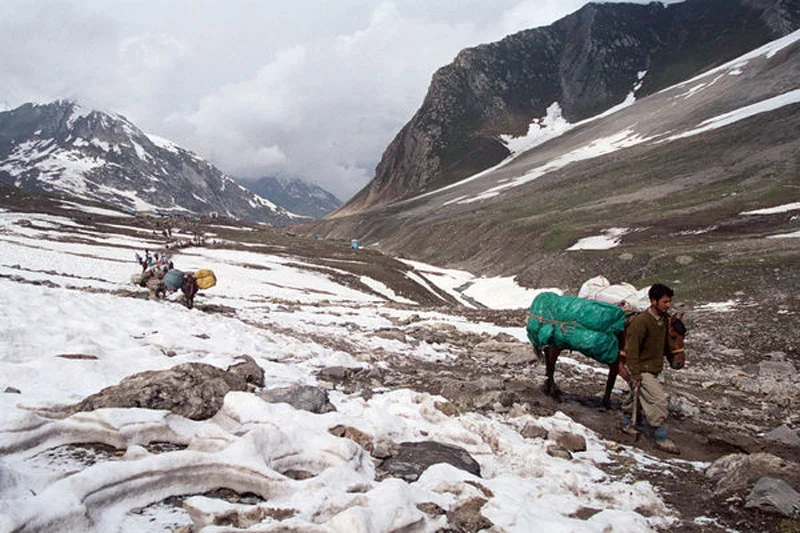
By Ulfat Majeed
JAMMU and Kashmir is famous for its pristine and abundant water resources that include lakes, rivers, springs, wetlands, snow and ice reserves. These water resources support agriculture, local and adventure tourism and hydropower which form backbone of the economy of the region. Global warming, which has been documented to be more pronounced in the High Mountain Asia, has adversely affected the water resources of the region in the recent years. The abrupt changes in these resources could have serious implications on the water security of the region. It could lead to shifting cropping patterns, decreased streamflow, depleted groundwater, water-related hazards, besides affecting the sustenance of the various communities that directly depend on water for their livelihood.
One of the most important reserves for water is the cryosphere which includes the glaciers, seasonal snow, snow-packs and permafrost. The Himalayan mountain range, also referred to as Third Pole, has the highest concentration of glaciers outside the Polar Regions. The Himalayas host more than 50000 glaciers with over 10,000 glaciers in the Jammu and Kashmir region. Some of the largest glaciers outside the poles that include the Siachen Glacier, the Biafo Glacier, the Baltoro Glacier, the Hipsar Glacier, to name a few, are located in this region. The valley of Kashmir hosts about 90 glaciers, the Kolahoi glacier being the largest. The Zanskar region too has a fair number of glaciers with some large glaciers that include the Drang Drung glacier, the Parkhachik glacier etc. The region has a substantial area under permafrost which, unfortunately, is poorly documented and remains the least researched component of the Himalayan Cryosphere. The seasonal snow supplies water to the rivers in spring and early summer months. From August to October, the streamflow is predominantly glacier melt. Any change in these ice reserves could directly affect the amount and timing of the water supply, hence affecting the downstream population. The depleting snowfall patterns will not only affect the stream flows, but also might impact the snow-tourism in the region.
Remote sensing, to be simply put, monitors these reserves from space. The data for such analysis could be an aerial photograph, a satellite image or even a drone survey! These data provide synoptic views of the resources and are effective in studying the changes that these reserves have undergone with time. The temporal changes could be studied even at daily interval while spatial changes could be tracked at sub-meter resolution. The back in time image of the same area is the easiest and the best way to study the spatiotemporal dynamics of the water resources. The earth observation satellite data besides areal changes can be used for quantifying various other factors that could affect glacier health and include hydrometeorological parameters, aerosol distribution, snow and rock avalanches, etc.
For the sustenance of these important ice reserves, it is imperative to have a robust state policy to monitor these reserves in space and time. Geoinformatics, making use of concepts of information science, integrates data from multiple sources that include but not limited to satellites, ground truth, field surveys and ancillary sources in a Geographic Information System (GIS), is beneficial for policy making for the sustenance of these important reserves. Research conducted at the University of Kashmir and elsewhere clearly indicates that the glaciers in the region are receding at exacerbated rates as compared to other parts of the Himalayan arc, primarily driven by climatic change. The recession of glaciers has also resulted into formation of glacial lakes at the glacier tongues, referred to as proglacial lakes. These proglacial lakes are impounded by lose glacier debris material called moraine. While these unconsolidated moraines have a capacity to hold water, they may burst anytime releasing huge water volumes and translating into what are called as Glacial Lake Outburst Floods (GLOF). Some of the smaller GLOFs have been reported from the Ladakh and Karakoram regions but it is highly likely that the frequency of GLOFs may increase in the future owing to the receding pattern of glaciers. Besides monitoring ice reserves, a check on the hazards posed by them is a prerequisite for the mitigation of the risk that a GLOF event could pose to downstream population. The geoinformatics technology has been used widely world over to document and mitigate these hazards. Many areas in the Himalayas itself that include Nepal, Bhutan etc have developed Early Warning Systems that inform of a possible disaster before it could actually strike, hence helping in save lives and infrastructure downstream.
The J&K State Water Resources Regulatory Authority can direct the government to use geomatics technology by recruiting trained GIS professionals who can help achieve the set goals. The University of Kashmir and its sister university, the University of Jammu have been successfully running the professional Masters programme in Geoinformatics from past several years. Additionally, there are professionals from outside institutions that are ready to serve the state. The state has the requisite professional base that can efficiently inform policy makers by using geomatics technology to help frame policies aimed at safeguarding pristine water resources of the region.
- Ulfat Majeed is a DST-INSPIRE Fellow currently pursuing Ph.D Geoinformatics at the University of Kashmir and can be reached at ulfatmgis@gmail.com
Follow this link to join our WhatsApp group: Join Now
Be Part of Quality Journalism |
Quality journalism takes a lot of time, money and hard work to produce and despite all the hardships we still do it. Our reporters and editors are working overtime in Kashmir and beyond to cover what you care about, break big stories, and expose injustices that can change lives. Today more people are reading Kashmir Observer than ever, but only a handful are paying while advertising revenues are falling fast. |
| ACT NOW |
| MONTHLY | Rs 100 | |
| YEARLY | Rs 1000 | |
| LIFETIME | Rs 10000 | |











